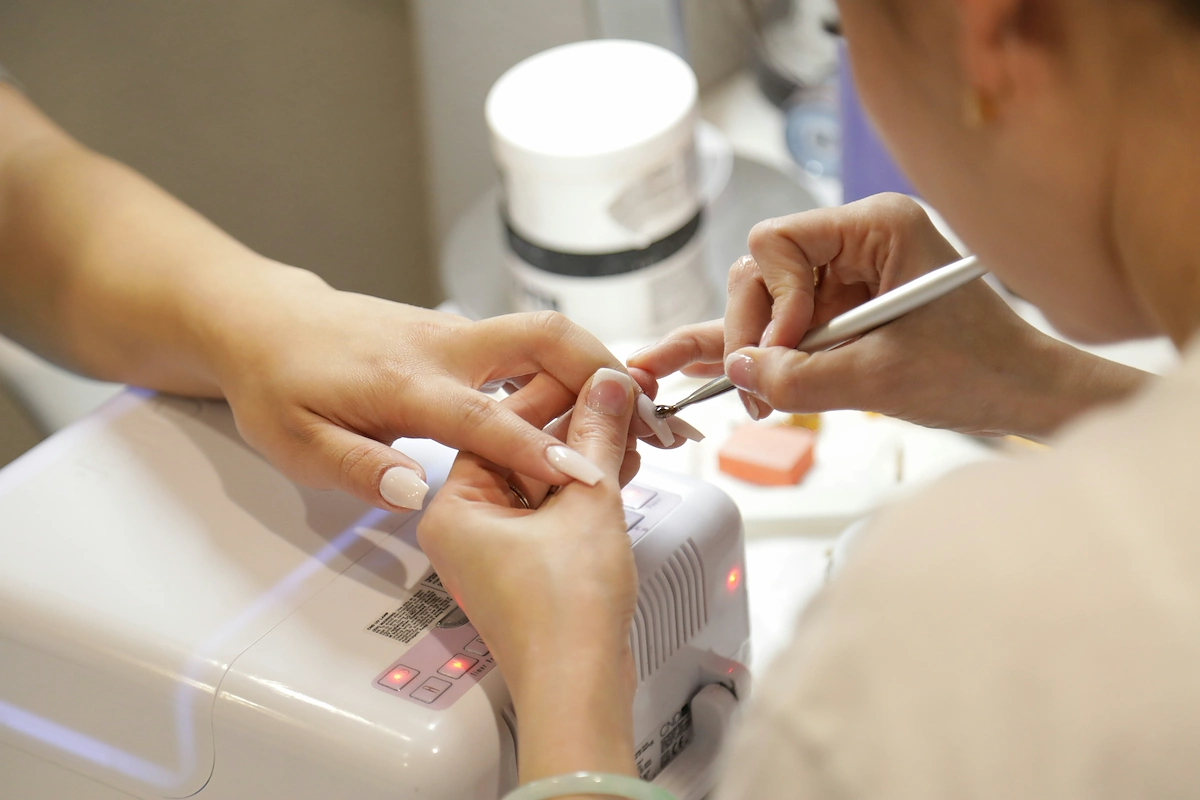Starting a nail salon is a rewarding venture, blending creativity and attention to detail with smart business sense. The industry is worth billions, fueled by a steady demand for manicures and pedicures from everyone from busy professionals to brides-to-be.
This guide will take you through the practical steps of validating your business concept, securing funding, obtaining necessary licenses, and selecting the right location to help you launch a successful nail salon business in the U.S.
Step 1: Plan and validate your business idea
Start by researching your local market. Spend a few weeks visiting other nail salons as a customer to observe their service quality, pricing, and atmosphere. Note how busy they are on a Tuesday afternoon versus a Saturday morning.
Use Google Maps to plot every salon in a three-mile radius. Read their online reviews on Yelp and Google to find common complaints and praises. This free research reveals what customers in your area want and what your competitors lack.
Figure out your startup costs
A clear budget is your roadmap. Initial investments can range from $25,000 to over $150,000, depending on your location and scale. Your biggest expenses will be the salon build-out and equipment, so plan accordingly.
Expect to spend $10,000-$75,000 on renovations. Quality pedicure chairs and manicure stations can add another $5,000-$30,000. A frequent misstep is underbudgeting for initial inventory, so set aside at least $3,000-$10,000 for polishes and supplies.
Here are 4 immediate steps to take:
- Visit at least five local competitors to analyze their pricing and service.
- Create a detailed spreadsheet to track all potential startup costs.
- Survey 25 potential clients in your target neighborhood about what they look for in a nail salon.
- Draft a simple business plan that defines your target customer and unique offerings.
Step 2: Set up your legal structure and get licensed
Most new salon owners form a Limited Liability Company (LLC). This structure protects your personal assets, like your house, from business debts. Profits pass through to your personal tax return, which simplifies tax filing. The cost to register an LLC is between $50 and $500.
Next, get a free Employer Identification Number (EIN) from the IRS website. You need this to hire employees and open a business bank account. The online application takes less than 15 minutes to complete.
Secure your state and local licenses
Your state's Board of Cosmetology is the main regulatory body. You will need a salon license, which can cost $100-$500 and take 4-8 weeks to process. A common mistake is to hire technicians without a valid state license; always verify their credentials before you make an offer.
Also, contact your city's planning department for a Certificate of Occupancy (CO). This confirms your salon meets all building and safety codes. You will also need a seller's permit from your state's tax agency to collect sales tax on services and products.
Here are 4 immediate steps to take
- Register your business as an LLC with your Secretary of State.
- Apply for a free EIN on the IRS website.
- Review your state's Board of Cosmetology website for salon license requirements.
- Contact your local city hall to ask about the Certificate of Occupancy process.
Step 3: Secure your insurance and manage risk
Your salon needs several types of insurance. General liability covers client slips and property damage. You also need professional liability insurance for claims related to your services, such as an infection or allergic reaction. A frequent oversight is assuming general liability covers service errors, but it does not.
You might consider a Business Owner's Policy (BOP), which bundles general liability and property coverage. For a policy with $1 million in coverage, annual premiums often range from $600 to $1,500. Separate professional liability insurance can add another $500 to $1,200 per year.
If you hire employees, you must have workers' compensation insurance. This policy addresses medical costs and lost wages for work-related injuries, like reactions to chemical fumes. The cost varies by state and payroll size, so research your local requirements early.
Work with providers who specialize in the beauty industry. Companies like Hiscox, The Hartford, and Next Insurance understand the specific risks of a nail salon. A general agent may not find you the right coverage for your unique needs.
Here are 4 immediate steps to take:
- Get quotes for a Business Owner's Policy from at least two different providers.
- Confirm any professional liability policy explicitly covers infections and allergic reactions.
- Research your state's workers' compensation laws before you hire your first technician.
- Ask potential insurers about their experience with other salon clients.
Step 4: Choose your location and buy equipment
Look for a commercial space between 800 and 1,500 square feet. Your city will likely require the location to have a commercial zoning classification. Check your local zoning map online before you even contact a landlord to avoid wasted time.
Negotiate your lease
When you find a potential space, ask the landlord for a Tenant Improvement (TI) allowance. This is money they provide for you to build out the space. You will need it for plumbing for pedicure chairs and proper ventilation systems, which are non-negotiable for a salon.
Many new owners make the mistake of verbally agreeing to improvements. Get every detail, from the TI allowance to the exact location of new plumbing lines, specified in the written lease agreement. This protects you from future disputes and unexpected costs.
Purchase your equipment and supplies
Your main equipment costs will be pedicure chairs, which run $1,500-$5,000 each, and manicure stations at $300-$1,000 apiece. You also need a medical-grade autoclave for sterilization, which costs between $1,000 and $3,000. Budget for these items first.
For polishes and consumables, you can work with suppliers like Universal Companies or find a local beauty distributor. Some distributors offer professional pricing but may require a minimum first order, often around $500. Always compare prices from at least two suppliers.
Here are 4 immediate steps to take:
- Research commercial zoning laws for your target neighborhood on your city's website.
- Ask landlords about their Tenant Improvement allowance policy for salon-specific needs.
- Price out a full equipment package from two different industry suppliers.
- Review your local building code requirements for salon ventilation systems.
Step 5: Set up your payment processing
Your clients will expect to pay with credit cards, debit cards, and digital wallets. Look for a payment solution with transparent pricing. Many processors charge 2.5% to 3.5% per transaction plus monthly fees, which can add up quickly.
Handle deposits and payments
For group bookings or bridal parties, you might want to require a deposit to prevent no-shows. A payment system that lets you easily invoice or charge a card on file simplifies this process. This protects your revenue and schedule.
For salons that need to accept payments on-site, JIM offers a streamlined solution. With JIM, you can accept debit, credit, and digital wallets directly through your smartphone—just tap and done. At just 1.99% per transaction with no hidden costs or extra hardware, it's particularly useful for keeping your front desk clutter-free.
- Get Started: Download the JIM app for iOS.
- Make a Sale: Type the sales amount, hit sell, and ask your customer to tap their card or device on your phone.
- Access Funds: Your money is available right on your JIM card as soon as the sale is done—no waiting for bank transfers.
Here are 3 immediate steps to take:
- Compare transaction fees from two traditional payment processors.
- Establish a deposit policy for group appointments.
- Download the JIM app to explore its features on your phone.
Step 6: Secure funding and manage your finances
Find the right funding
The Small Business Administration (SBA) is a great place to start. Their 7(a) loans are popular for new salons, with amounts often between $50,000 and $150,000. You will need a solid business plan and a credit score over 680 to qualify for these.
Expect interest rates around 2-4% above the prime rate. You might also look into equipment financing, which lets you borrow specifically for big-ticket items like pedicure chairs. This can free up cash for other needs and often has a simpler approval process.
Plan your working capital
With funding secured, your focus shifts to cash flow. Plan to have at least $15,000 to $30,000 in working capital. This covers rent, payroll, and supplies for the first six months while you build your client base. A frequent misstep is to only budget for startup costs.
Without enough working capital, you could run out of cash before your salon becomes profitable. It is a good practice to always have a six-month cushion. This buffer ensures you can handle unexpected expenses without stress.
Here are 4 immediate steps to take:
- Review the SBA 7(a) loan checklist on the SBA website.
- Contact a lender to pre-qualify for an equipment loan.
- Calculate your estimated operating expenses for the first six months.
- Open a separate business checking account to keep finances clean.
Step 7: Hire your team and set up operations
Build your team
Your first hire should be at least one licensed nail technician. In most states, they must hold a current nail technician or cosmetology license. Always verify their credentials with your state's board before you extend an offer. This simple check protects your business from legal trouble.
You can pay technicians an hourly wage, typically $15-$25 plus tips, or a commission of 40-60% on their services. A mistake many new owners make is misclassifying staff as independent contractors. Classify your team as W-2 employees to avoid costly IRS penalties down the road.
Streamline your daily operations
Manual appointment books create chaos. Use a salon management software like Vagaro or Fresha from day one. These platforms handle online booking, client reminders, and payment processing, which frees you up to focus on service quality and growth.
As you staff up, keep an eye on your payroll. A healthy benchmark for a nail salon is to keep total staff costs between 35% and 50% of your gross revenue. This ratio helps ensure your business remains profitable as it scales.
Here are 4 immediate steps to take:
- Draft a job description for a licensed nail technician that outlines compensation.
- Research your state's laws on employee classification (W-2 vs. 1099).
- Sign up for a free trial of a salon management software like Fresha or Vagaro.
- Calculate your target payroll budget based on projected first-year revenue.
Step 8: Market your salon and get customers
Your salon's portfolio is visual, so make Instagram your best friend. Post high-quality photos and videos of your best nail art daily. Use local hashtags like #[YourCity]Nails to attract nearby clients. A mistake many new owners make is posting blurry or poorly lit photos.
Once that's set up, claim your free Google Business Profile. This action puts you on the map and lets customers leave reviews. Encourage your first happy clients to write a review, as positive feedback on Google and Yelp is powerful social proof that drives foot traffic.
You should also market your business offline. Reach out to local businesses for partnerships. You could connect with a nearby bridal boutique to offer a special package for wedding parties or provide a 10% discount for employees of a large office building down the street.
Set a marketing budget of 5-10% of your projected monthly revenue. If you run paid ads on social media, aim for a Customer Acquisition Cost (CAC) below $50 per new client. Track this metric to ensure your ad spend is effective.
Here are 4 immediate steps to take:
- Claim and complete your Google Business Profile.
- Create a grand opening special, like 20% off all services for the first week.
- Contact two local businesses to propose a partnership.
- Set up an Instagram account and post five high-quality photos of your work.
Step 9: Set your service prices
Your prices send a message about your brand. Before you decide, review the service menus of at least five competing salons in your area. A frequent error is to price too low to attract clients, which can make it difficult to be profitable or raise prices later.
Calculate your cost per service
For each service, calculate your direct costs. This includes polish, remover, cotton, and other consumables. A basic manicure might cost $5-$8 in supplies. You must also factor in the technician's time, which is your largest expense per service.
Aim for a service profit margin of 70-80% before you account for labor and overhead. For retail products like lotions or polishes, the industry standard is a 100% markup. If a bottle of polish costs you $6, you should sell it for $12.
Choose your pricing structure
Most salons use à la carte pricing, where each service has a set price. You can also offer packages, like a manicure and pedicure bundle for 10% off the individual price. This encourages clients to book multiple services and increases the average ticket value.
Consider a tiered menu to give clients options. For example, a "Classic Manicure" could be $35, a "Deluxe Manicure" with extra massage could be $50, and a "Spa Manicure" with a paraffin treatment could be $65. This structure caters to different budgets.
Here are 4 immediate steps to take:
- Calculate the supply cost for your three most popular services.
- Research the prices of five local competitors for those same services.
- Draft a tiered service menu with at least two price levels per service.
- Set retail prices for your products using a 100% markup.
Step 10: Maintain quality and scale your business
Establish your quality standards
Your reputation hinges on consistency. A great first step is to require every technician to complete their Barbicide certification for sanitation. This is a non-negotiable standard that shows clients you prioritize their health and safety.
With that covered, you can track your key performance metrics. Your client retention rate should be at least 60-70%. Also, monitor your average ticket value. Your salon software, like Fresha or Vagaro, can generate these reports for you.
If these numbers dip, it is a clear sign that service quality may be slipping. You can then address the issue with specific staff training or by surveying clients for direct feedback.
Know when to grow
Once your quality is consistent, you can plan for growth. A good rule of thumb is to hire a new technician when your current staff is 80% booked for two consecutive months. This prevents burnout and stops you from turning away potential clients.
Many owners make the mistake of expanding too soon. Before you think about a second location, make sure your first salon is consistently profitable for at least one full year. You should also have a daily waitlist and operate at over 85% capacity.
Here are 4 immediate steps to take:
- Require every technician to complete their Barbicide certification.
- Use your salon software to find your current client retention rate.
- Check your booking calendar to see which technicians are over 80% booked.
- Set a profit goal for your first year before you consider expansion.
Starting a nail salon is about more than just polish. Your success depends on the client experience you create. Remember that sanitation and service are your best marketing. You have the roadmap, now go build your dream salon.
As you welcome clients, a simple payment process helps. JIM turns your phone into a card reader for a flat 1.99% fee, with no extra hardware. It keeps things simple so you can focus on your clients. Download JIM and get paid.















